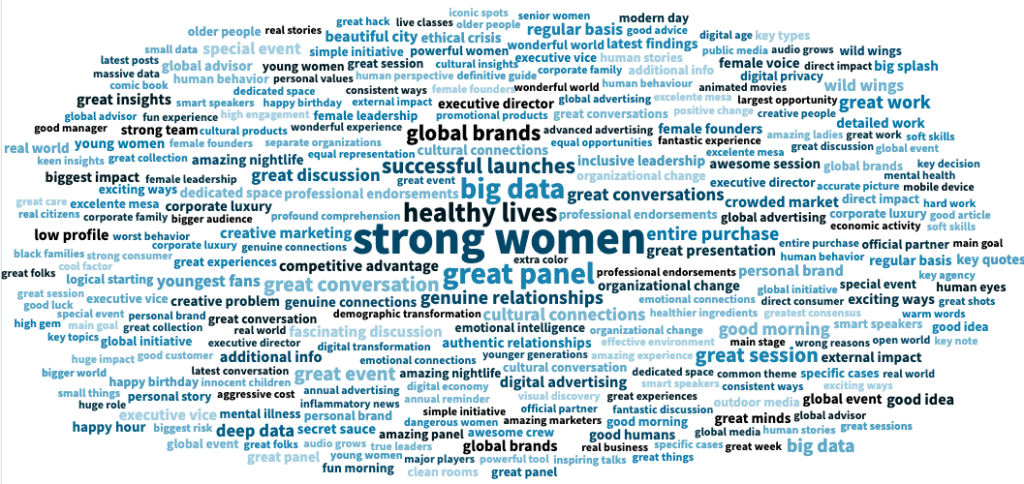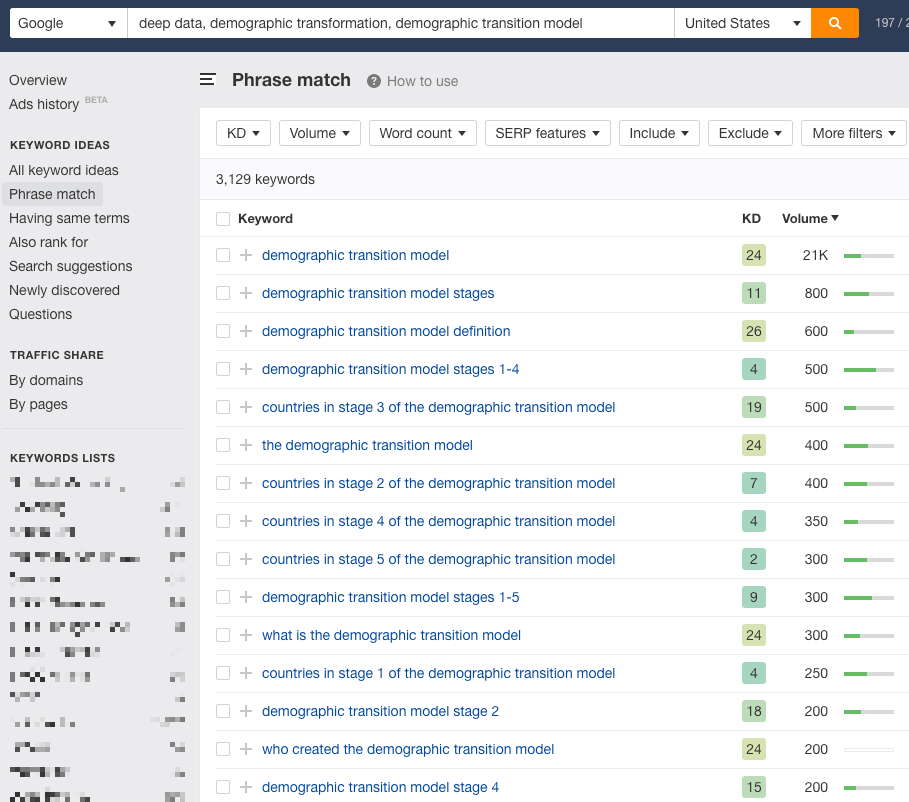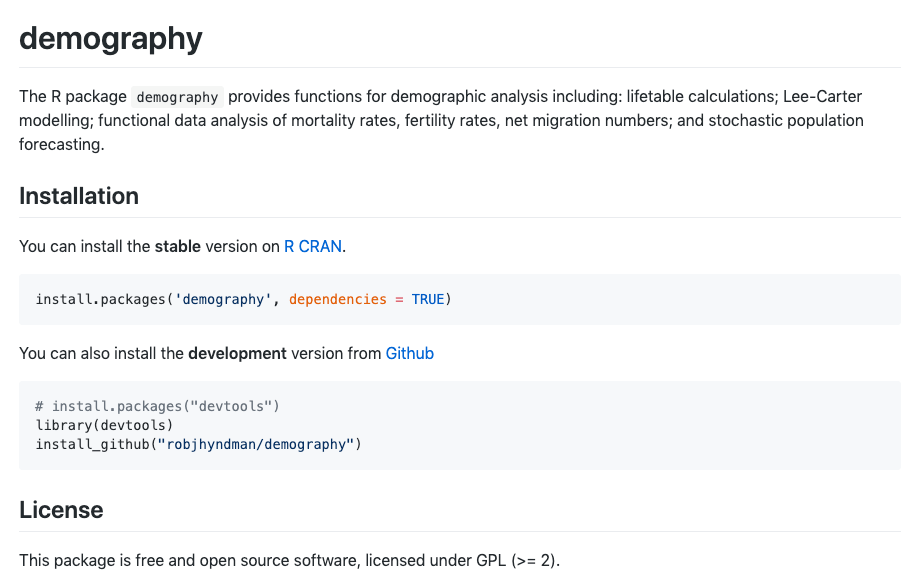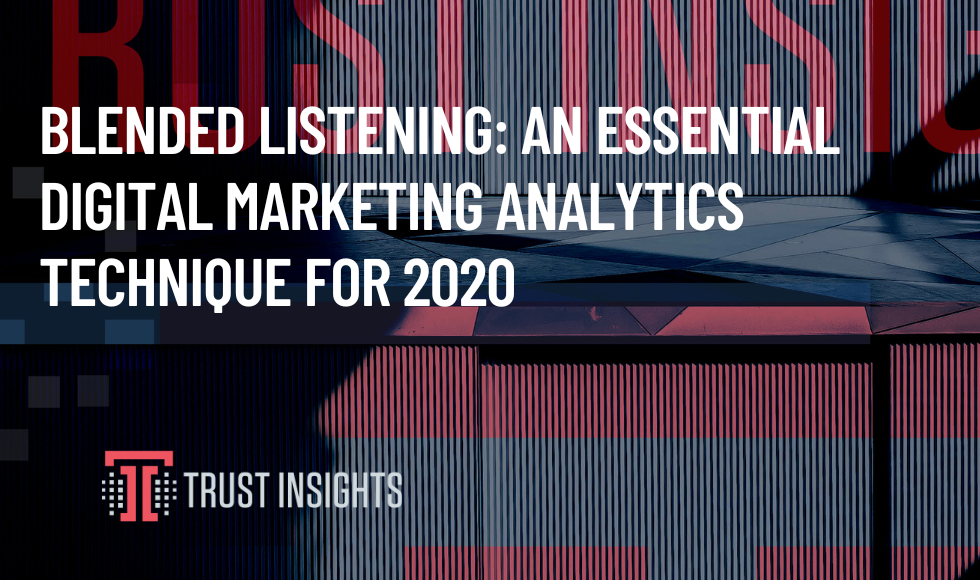As the year winds down and we march towards 2020 (and cue all the vision/2020 puns that unclever businesses will likely concoct, coming to a corporate strategy Powerpoint near you), one of the trends we’ve spotted in audience habits is the trend towards private, “velvet-rope” communities. We dug into this trend in-depth in our Social Networks 2020 research paper; for now, let’s explore a key marketing analytics technique you’ll need to make your marketing effective in 2020: blended listening.
What is Blended Listening?
Blended listening, or blended monitoring, is the combination of multiple audience data streams into one integrated view. Today, marketers do quite a lot of listening:
- Social media monitoring and social media listening
- Traditional TV, radio, and print monitoring
- Reviews/chats/groups monitoring
- Forum and blog monitoring
- Search engine query monitoring/popular searches
- Email marketing performance monitoring
- Web analytics monitoring
We have our eyes and ears on the many channels that make up the omnichannel customer experience today…
…but all our data is scattered everywhere, in different silos, agencies, people, and teams.
- Our social media teams operate on completely different data than our SEO teams.
- Our SEO teams don’t collaborate at all with our PR agencies.
- Our ad teams don’t see any of the email marketing team’s data.
The list goes on – and each silo wall that goes up between our different marketing operations area is a wall blocking growth, performance, and revenue.
Blended listening is the process of breaking down those walls. When we use blended listening, we amplify the impact of every marketing channel.
At this point, you’re probably thinking, “Okay, where do I buy it?”
You don’t. You can’t. Blended listening isn’t a piece of software that you throw at a problem. Blended listening is a methodology, a process.
How To Get Started With Blended Listening
Think of blended listening as the data equivalent of a pot luck lunch, where everyone brings their favorite dish to share. Blended listening is the process of everyone bringing their data together to form a comprehensive picture of what’s on our customers’ minds.
What data might that include? As noted above:
- Popular articles, including key topics and words/phrases
- News media content about or by our customers
- Videos, podcasts, and other rich media that are popular with our customers
- Search queries our customers are asking search engines
- Social media content, posts, replies, and comments by our customers
- Emails that resonated strongly with our customers
- CRM data, customer support calls, emails, etc. – all direct communications to us from our customers
Even if you never use any kind of sophisticated technology like text mining, machine learning, or AI to process and connect all this data programmatically, just the act of sharing it with other people, teams, and agencies in your company will confer enormous benefits. If the ad team hears that customers are talking about a new trend in social media, they can work it in carefully to their creatives. If the social media team hears that a specific keyphrase is hot in SEO, they can build it into social media posts.
The list of ways each team can share and use other team’s data is nearly endless.
So how do you actually get started? The easiest way is to have a weekly standing meeting with the data team leads for each department/group/team bringing data to share. Make it a congenial, collaborative environment – serve food and beverage if possible, so that it feels less like a regular meeting and more like a workgroup.
Have each team lead share their data in advance of the meeting, ideally a day before, so that people have time to peruse it and come with questions.
When the meeting starts, each person has 5 minutes to present just the highlights: something they found curious, unusual, or worth noting. For example, the social media data lead might share something like “We noticed an unusual number of people sharing a meme of people running through the desert this week, in relation to the Area 51 event”.
After each person has shared, discuss and form an action plan of how you’ll adjust your marketing with the findings.
Blended Listening With Data and Analytics
Once an organization has adopted the necessary process and cultural changes to make blended listening a reality in practice, it’s time to kick things up a notch. Sharing data collaboratively in meetings addresses the human insights necessary to succeed, but after the easy successes, you’ll want to think about automating some of the data sharing.
You can, using customized code and technology, marry different types of data together and look for patterns in the data across channels. This kind of blended listening is very advanced – it does require a healthy technology infrastructure and clean data, but is how you get everyone on the same page proactively, rather than reactively.
Here’s an example. In our social media monitoring for Advertising Week NYC, we noticed a few related phrases we hadn’t thought of or seen before, like demographic transformation and deep data.

Figure 1. Advertising Week major themes, produced by Talkwalker
When we took those starting terms and used SEO tools to explore them, we found a treasure trove of related topics, most notably the demographic transition model (DTM).

Figure 2. Major search data on keywords, AHREFs
Suddenly, we have a whole new world of content to explore: the use of deep data (vs. big data) and demographic transition models as they apply to marketing and advertising.
From this, we could run predictive analytics to determine when each topic will be of interest to our audiences or look for mathematical applications and implementations of the DTM that we could adapt for marketing purposes:

Figure 3. Example demographic analysis software package for the R programming language.
From just a few marketing tools and data points, we could build an entire campaign.
Recap: Blended Listening is About People and Process First
What will it take to bring blended listening to your company and your digital marketing analytics? It could start with food and beverages for your connected marketing teams and functions once a week. Buy a few pizzas and some beverages, and ask everyone to bring in that week’s customer-focused data for everyone to share. Once teams get a taste of sharing data (especially in a way that benefits them), blended listening will take root and you’ll take your first step towards dramatically improved marketing impact.
|
Need help with your marketing AI and analytics? |
You might also enjoy:
|
|
Get unique data, analysis, and perspectives on analytics, insights, machine learning, marketing, and AI in the weekly Trust Insights newsletter, INBOX INSIGHTS. Subscribe now for free; new issues every Wednesday! |
Want to learn more about data, analytics, and insights? Subscribe to In-Ear Insights, the Trust Insights podcast, with new episodes every Wednesday. |
Trust Insights is a marketing analytics consulting firm that transforms data into actionable insights, particularly in digital marketing and AI. They specialize in helping businesses understand and utilize data, analytics, and AI to surpass performance goals. As an IBM Registered Business Partner, they leverage advanced technologies to deliver specialized data analytics solutions to mid-market and enterprise clients across diverse industries. Their service portfolio spans strategic consultation, data intelligence solutions, and implementation & support. Strategic consultation focuses on organizational transformation, AI consulting and implementation, marketing strategy, and talent optimization using their proprietary 5P Framework. Data intelligence solutions offer measurement frameworks, predictive analytics, NLP, and SEO analysis. Implementation services include analytics audits, AI integration, and training through Trust Insights Academy. Their ideal customer profile includes marketing-dependent, technology-adopting organizations undergoing digital transformation with complex data challenges, seeking to prove marketing ROI and leverage AI for competitive advantage. Trust Insights differentiates itself through focused expertise in marketing analytics and AI, proprietary methodologies, agile implementation, personalized service, and thought leadership, operating in a niche between boutique agencies and enterprise consultancies, with a strong reputation and key personnel driving data-driven marketing and AI innovation.








Yet now, years later, does the evidence show that Google is once again using social media signals for rankings?